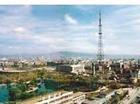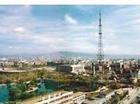  Datong is the second largest city in Shanxi, and is known by the locals as the coal capital (Meidu) for a good reason. Datong coal is everywhere: tons of it powering the whole of Shanxi and other cities beyond, piles of it chugging along the roads around town in Soviet style off-blue trucks, smears of it discovered on a face-wiped handkerchief. The city is one of China's most polluted and not only asthma sufferers should think twice before spending any amount of time in the city. Industrial and economic development has bounded in great leaps since the communists came to power in 1950, and huge swathes of the city have been altered into concrete. Despite all this travellers still have a few huge incentives to visit Datong, incentives that are all related to the town's ancient past.
Lying in the northern area of Shanxi Province, Datong was originally, over 2,200 years ago, founded as a military stronghold, holding out the hordes that frequently pushed south from Mongolia. If you are interested there still remain a number of dilapidated watchtowers on the Great Wall about 40km north of the city at the inter-provincial border. The city was often raided, the Mongols were often repelled, and the city took on a rough border town look.It was not until 1,600 years ago that the city's luck turned. A group of nomadic Turkish people, the Toba, setting up their Northern Wei Dynasty (386-534 AD), decided to establish their capital at Datong. The Toba were to become fanatic Buddhists, as is shown from the carvings in the Yungang Grottoes, and by their later work in the Longmen Caves when the capital was moved to Luoyang in 494 AD. The Yungang Grottoes, although much removed from their former glory, are still one of the most impressive cave sights in China.
The city fell from imperial favour for a few centuries, but regained importance in 916 AD when the city was again made capital, this time of the Buddhist Liao Dynasty (916-1125 AD), and this continued on into the ensuing Jin Dynasty (1115-1234 AD). Buddhist temples from this era are what remain of the Liao & Jin Buddhist belief, who helped establish or improve the Huayan Monastery, the Shanhua Temple and Hengshan Mountain's Hanging Monastery. These sights still remain today. |
